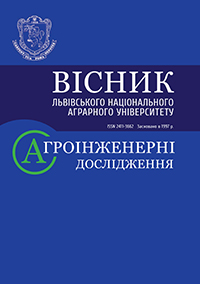INVESTIGATION ON THE EFFECT OF APPLICATION OF THE FACTIONS OF SAPROPEL ON THE ENERGY INDICATORS OF BRIQUETTES MADE FROM THE SRAW AND COMMON FLAX HURDS
DOI:
https://doi.org/10.31734/agroengineering2018.01.113Keywords:
hurds, flax straw, heat of combustion, sapropel, fuel cork, cake/briquetteAbstract
The article presents the results of experimental studies of combustion heat and calorific value of briquettes on the basis of straw and flax hurds with the addition of sapropel fraction. The calorific value was determined by burning briquettes, based on the standard PN-C-04062: 2018-05, which operates in Poland. The explored models of briquettes were made in the Laboratory of Energy and Biofuels of the Malopolska Center for Renewable Energy "BioEnergia", Krakow, Poland. Fraction of straw and retted straw, as well as sapropel, were obtained in the laboratory of Lutsk National Technical University. The moisture content of straw used for briquettes production was 10%.
During experimental studies, the effect of adding sapropel fractions (30 and 50%) on the caloric value of briquettes made from the hurds and flax straw, in particular their combustion heat and calorific value, was established.
The results of experimental studies have shown that the highest values of calorific value are briquettes from the hurds, slightly smaller ones – from the flax straw, and the smallest - from these materials with addition to their composition of 30 and 50% sapropel. Humidity of the material used for the production of briquettes was 10%. The investigated models of briquettes were produced at the Energy and Biofuels Laboratory of the Malopolska Center for Renewable Energy "BioEnergia". Fraction of straw and retted straw, as well as sapropel, were obtained in the laboratory of Lutsk National Technical University.
According to the results of the research it was established that the heat of burning hurds is 22,2 MJ/kg, adding 30% sapropel causes decrease of this index by 16,6%, to 18,5 MJ / kg, and addition of 50% – by 48,2%, to 11.5 MJ/kg. The heat of combustion of flax straw is 19.7 MJ / kg, adding 30% of sapropel causes a decrease of 30%, to 13.8 MJ/kg, and the addition of 50% sapropel – by 50%, up to 9.7 MJ/kg . It should be noted that the addition of 30% sapropel to the hurds reduces its calorific value by 16.6%, and the addition of 30% sapropel to flax straw – by 30%.
Since sapropel being of organic origin in a hardened state does not burn, but is smoldering, the study of combustion time of fuel briquettes with the contents of said raw materials is promising.
References
Arhangelskiy Yu. L. Ispolzovanie izmelchennyih drevesnyih othodov v torfobriketnom proizvodstve. Torfyanaya promyishlennost. 1990. № 7. S. 22–24.
Bordun T. V. Klasyfikatsiia i kharakterystyka tverdykh alternatyvnykh vidnovliuvanykh vydiv biolohichnoho palyva. Naukovi pratsi Odeskoi natsionalnoi akademii kharchovykh tekhnolohii. 2013. № 4. S. 71–76.
Hrytsenko V. T., Bakardzhyiev R. O. Perspektyvy otrymannia bilkovykh dobavok ta tverdoho biopalyva z nasinnia oliinykh kultur. Mekhanizatsiia ta elektryfikatsiia silskoho hospodarstva: mizhvid. temat. nauk. zb. Hlevakha, 2013. Vyp. 98, t. 2. S. 152–157.
Dubrovin V. O., Korchemnyi M. O., Maslo I. P. ta in. Biopalyva (tekhnolohii, mashyny i obladnannia). Kyiv: TsTI «Enerhetyka i elektryfikatsiia», 2004. 256 s.
Korinchuk D. M., Mykhailyk V. A., Korinchuk K. O. Doslidzhennia strukturno-mekhanichnykh vlastyvostei kompozytsiinykh bryketiv na torfianii osnovi z vykorystanniam orhanichnykh pobutovykh vidkhodiv. Promyslova teplotekhnika. 2009. T. 31, № 7. S. 53–58.
Rusakov D., Didukh V., Tomiuk V. Promyslove vyrobnytstvo orhanichnykh, orhano-mineralnykh ta hranulovanykh dobryv na osnovi sapropeliv. Visnyk Lvivskoho natsionalnoho ahrarnoho universytetu: ahroinzhenerni doslidzhennia. 2014. № 18. S. 37–42.
Adamczyk F., Frąckowiak P., Mielec K., Kośmicki Z. Trwałość brykietów ze słomy przeznaczonej na opał, uzyskanych metodą zwijania. Journal of Research and Applications in Agricultural Engineering. 2005. 51(1). S. 33–36.
Denisiuk W. Produkcja roślinna jako źródło surowców energetycznych. Inżynieria Rolnicza. 2005. 5(80). S. 123–131.
Denisiuk W. Słoma – potencjał masy i energii. Inżynieria Rolnicza. 2008. 2(100). S. 23–30.
Didukh V., Tomyuk V., Onyukh Yu., Lalak-Kańczugowska Ju. Analysis of studies of lake sapropel properties. Teka Commission of Motorization and Power Industry in Agriculture. 2016. Vol. 16, No. 3. P. 89–94.
Fiszer A. Badania porównawcze współczynnika trwałości brykietów ze słomy. Journal of Research and Applications in Agricultural Engineering. 2008. 53(3). P. 69–71.
Hejft R. Ciśnieniowa aglomeracja materiałów roślinnych. Białystok, 2002.
Hejft R. Wytwarzanie brykietów z odpadów roślinnych w ślimakowym układzie roboczym. Inżynieria Rolnicza. 2006. 5(80). S. 231–238.
Mani S., Tabil L. G., Sokhansanj S. Specific energy requirement for compacting corn stover. Bioresource Technology. 2006. No. 97. P. 1420–1426.
Niedziółka I., Szymanek M., Zuchniarz A. Energetic evaluation of postharvest corn mass for heating purposes. Teka Komisji Motoryzacji i Energetyki Rolnictwa. 2006. T. VI(6A). S. 145–150.
Niedziółka I., Szymanek M., Zuchniarz K. Ocena właściwości energetycznych i mechanicznych brykietów z masy pożniwnej kukurydzy. Inżynieria Rolnicza. 2007. 7(95). S. 153–159.
O’Dogherty M. J.; Huber A. J.; Dyson J.; Marshal C. J. A study of the physical and mechanical properties of wheat straw. Journal of Agricultural Engineering Research. 1995. 62(2). P. 133–142.
PN-C-04062:2018-05. Przetwory naftowe – Oznaczanie ciepła spalania paliw ciekłych w bombie kalorymetrycznej i obliczanie wartości opałowej z zastosowaniem wzorów empirycznych. 2018.
Produkcja biomasy na cele energetyczne / J. Frączek i inni. Kraków: PTIR, 2010.
Przetwarzanie biomasy na cele energetyczne / J. Frączek i inni. Kraków: PTIR, 2010.
Wcisło G. Determing the rapseed oil influence on Biodiesel RME top heat volue - 2007. Silniki Spalinowe. Development of Combustion Engines. 2007. R 46, № SC3. P. 201-205.
Wcisło G. Wyznaczenie ciepła spalania oraz wartości opałowej ulepszonych odmian rzepaku. MOTROL. 2010. Vol. 12. S. 181–187.


